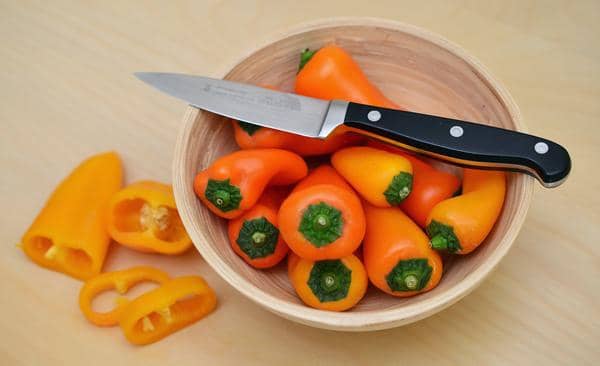
Dos and Don'ts of Cooking with Peppers
Share
Cooking with peppers can be intimidating. From the relatively mild bell peppers and jalapenos to sweat-inducing habanero chilis and tongue-scorching ghost peppers, there are hundreds of thousands of varieties to choose from, each with their own unique flavor profiles and heat ratings.
There are just as many different ways of enjoying peppers, from raw to roasted, either stuffed with beef and rice, mixed into sauce or soup, or even used to create a very delicious and affordable pepper jelly dip (hint, hint).
At Pepper Jelly, we love peppers just as much as you do (look, it’s right there in our name!). That’s why we put together this helpful list of dos and don’ts to ensure that your pepper-cooking exploits go off without a hitch.
DO Practice Proper Pepper Safety
Capsaicin, the chemical compound that makes peppers tingle your tongue, can also burn your eyes or even your skin in high enough concentration.
"One of my biggest tips in working with hot peppers is to wear gloves,” says food blogger Jessica Formicola, of Savory Experiments. “Touch your face and you'll be sorry, let alone take out your contacts. If you don't wear gloves, soak your fingers in vinegar or dairy, the higher the milk fat the better, to ease the burning pain."
DON’T Be Afraid to Adjust the Heat
How spicy is too spicy? That depends on who you’re cooking for. Remember to tailor your dishes to suit the palettes of those who will be eating them, whether that’s you or someone else.
"If you want to temper the heat a little bit, remove the membranes,” advises Jack Miller, founder of home improvement blog How I Get Rid Of, noting that the membranes (and seeds) contain most of a pepper’s capsaicin, thus most of its heat. On the other hand, if your diners want even more heat, don’t hesitate to leave the membranes in. You may even want to consider trying different kinds of peppers.
DO Research Different Pepper Types
Speaking of trying different kinds of peppers! Some people assume that all peppers taste the same and the only big difference between them is how hot they are. While heat does vary wildly from pepper to pepper (meaning it’s a good idea to know exactly what you’re working with before you start cooking), taste likewise runs the gamut, even within pepper sub-groups.
"Don’t assume the bell pepper colors taste the same,” says Jim Mumford, creator of the website Jim Cooks Food Good. “Green is grassier, and red is the most pronounced. Yellow and orange will be more mild and sweet."
DON’T Jump Right into the Deep End
If you’re cooking with peppers, there’s a good chance you think of yourself as someone who enjoys spicy food. So why not jump right into the deep end of the pool? Why not go all out and try the hottest peppers you can find?
The hottest pepper in the world rates at 3.18 million units on the spice-measuring Scolville Scale. That’s more than 30 times hotter than the blistering-but-edible habanero, which is itself 100,000 times hotter than your average bell or banana pepper. The point is, the deep end of the pepper pool is very, very, very deep indeed. If you really want to plumb its depth, don’t dive in headfirst. Try dipping a toe in and building up your heat tolerance first.
DO Use Other Ingredients Wisely
Cooking isn’t just an art form, it’s also a science. Specifically, it’s a form of chemistry; this means that the way you mix different ingredients together has a big impact on the final product. For instance, the lemons, limes, tomatoes, and pineapples can help reduce a dish’s heat, while fresh ginger can increase it. Some ingredients can even alter the physical properties of peppers.
"Use a sauce when you can,” recommends Jamie Hickey, a personal trainer, nutritionist and founder of Truism Fitness. “Cooking peppers with a liquid will help them come out of the skin more easily and create a texture that is easier to manage."
DON’T Focus on Heat Over Flavor
Pepper’s are mainly known for their heat. Even in this very article, we’ve focused primarily on how they can bring heat to a dish, how you can increase or decrease that heat, and even the physical danger that heat can cause if used improperly. It’s important, though, to remember that heat is not the most important element of a dish. Flavor is.
While it’s easy to get carried away focusing entirely on finding that perfect level of spiciness, don’t forget to balance that out with other tastes, like sweet or sour or savory. Even the hottest pepper doesn’t add much to a dish if that dish doesn’t taste good.
DO Try Pepper Jelly Dips and Spreads
We might be a little biased here, but we think that the very best way of enjoying not only the spice, but the full potential and flavor of peppers, is with Pepper Jelly dips and spreads. Pepper Jelly products cut out the hardest part of cooking with peppers, leaving you with a tasty, easy-to-use ingredient that brings sweetness and spice to any meal. No muss, no fuss.
Choose from any of our tongue-tingling varieties, including caribbean mango, cranberry habanero, southwestern chipotle, and more. One taste, and you’ll be coming back for more!
